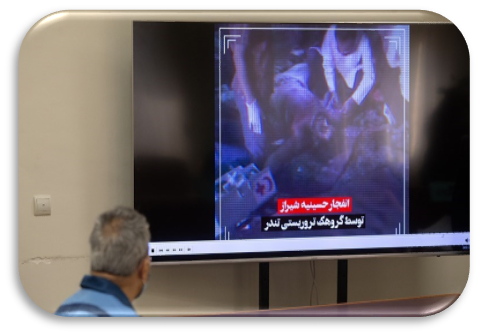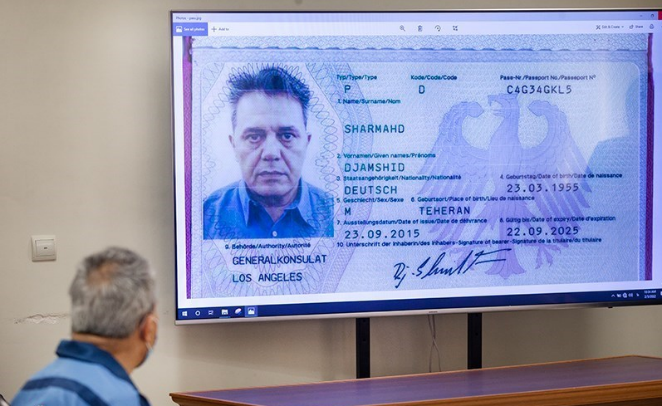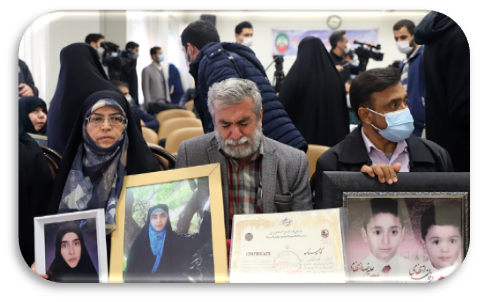HCHR- The trial of Sharmahd, the ringleader of the Tondar (Thunder), a terrorist group accused of committing terror attacks and anti-revolutionary operations against Iran, was held in a plenary court session presided over by Judge Abolqassem Salavati in the capital, Tehran.
The prosecutor's representative, the families of the victims of the group’s terrorist acts and the defendant and his lawyers were in attendance.
The highlights of the hearing is available here.
The Islamic Republic of Iran is among few nations to have been a major victim of terrorism despite taking various counter-terrorism measures. Over recent decades, more than 17,000 innocent civilians have lost their lives in terrorist operations carried out by a variety of terrorist groups. Enjoying the all-out support of the U.S. government, Jasmshid Sharmahd, the ringleader of the terrorist Kingdom Assembly of Iran grouplet, hereinafter referred to as Tondar, was carrying out terrorist operations prior to his arrest in July 2020.
The first court hearing for Sharmahd was held on 6 February 2022, at Division 26 of Islamic court of Revolution in the presence of the defendant’s defense attorney and a number of families of those who had lost their lives during a terrorist attack carried out by the abovenamed terrorist grouplet. At the hearing, the first section of the bill of indictment was read out by the prosecuting attorney and video clips from the Tondar-operated terrorist operations were projected. The first part of the bill of indictment was presented to the Court by the prosecutor, the highlights of which are listed hereunder:

Jamshid Sharmahd had planned to carry out 23 terrorist operations, 5 of which he managed to accomplish.
Jamshid Sharmahd, born in 1955, is a national of Iran, holding double nationality of Germany and residing in the United States. He is charged with planning and steering terrorist operations including a bombing at Hosseinieh Rahpouyan-e Vesal (a religious place) in Shiraz on 12 April 2008, which left 14 people dead and nearly 300 others injured.
Attempting to bomb the Sivand Dam on 16 November 2006 and planning to assassinate the dam project manager, bombing at the antechamber of the Imam Khomeini Mausoleum on 21 November 2009, setting fire at Jahan Hotel in Tehran while preparing a bomb to go off at the library of Grand Ayatollah Golpayegani Seminary and Tehran Book Fair are among other charges levelled against the defendant.
The terrorist Tondar grouplet was established in 2003 in the UK by a group of monarchists led by Fathollah Manouchehri and Foroud Fouladvand with a view to theorising anti-religious terrorism. After Sharmahd was elected to lead this terrorist grouplet in 2006, it switched to hard approach and terrorism, thereby embracing acts of terror at religious, economic and sensitive sites. Serving as intermediaries, the main elements of this grouplet in the U.S. offered terrorist training to set up several operational cells in Iran.
Prior to his arrest, Sharmahd had said: “We don’t feel ashamed to kill anyone. Did we ever deny responsibility for the Shiraz blast? We kill and spread terror!”

Planning and steering the bombing at Hosseinieh Rahpouyan-e Vesal in Shiraz on 21 April 2008, which left 14 dead and nearly 300 injured; 14 innocent children were among the casualties.
The defendant had also intended to blast a bomb in front of Iran’s Ministry of Foreign Affairs as well as the Embassy of China, both of which were thwarted after he was arrested. He had planned to carry out 23 terrorist operations, 5 of which he succeeded to accomplish.
He had planned and managed the bombing at Hosseinieh Rahpouyan-e Vesal in Shiraz on 12 April 2008, which left 14 dead and about 300 injured; 14 innocent children were among the dead and injured. The terrorist group released a statement, formally claiming responsibility for the terrorist operation.
After his operations, Sharmahd had established contact with U.S. officers. In 2003, he had migrated from Germany to the U.S. and had since resided there. Following the blast at Hosseinieh Rahpouyan-e Vesal in Shiraz, U.S. officials had established contact with him. The defendant has admitted that his first contact was with the FBI, during which he received some security tips.
He had also met with two local Senators and discussed the objectives and operations of the terrorist Tondar grouplet with them. The defendant has acknowledged that three FBI agents had contacted him for talks. In his statements, Sharmahd has revealed that U.S. officials had sent a professional IT team to his domicile and office in order to check his computer and communication systems and upgraded the security of his cybercommunications systems.
Sharmahd has said he had been in contact with 9 FBI and CIA agents with their last meeting taking place in January 2020. The defendant has stated that U.S. officials had warned him against leaving the U.S. territory, as they would no longer vouch for his safety. In his express acknowledgement, Sharmahd has – in the absence of any pressure or intimidation whatsoever – admitted to having been in contact with a political team from the FBI to discuss Tondar’s objectives in Iran. In 2015, he had talked to them about absorbing spying teams in Iran.
The defendant had been in contact with the CIA as well. He had shared all the IDs and passwords of the group with FBI officers and had had correspondence with the U.S. President and Secretary of State. Sharmahd had submitted his plan for the conquest of Tehran as well as so-called Cyrus Path to Trump, John Bolton and Brian Hook. In one of his addresses, Hook had mentioned the Tondar grouplet.
After the Hosseinieh blast in Shiraz, some U.S. print media as well as Fox News and CNN had interviewed the defendant. Based upon Sharmahd’s acknowledgement, the U.S. government had granted him various visas including visa to establish a trade company, visa for the victims of political refugees in the U.S., as well as right to transaction, right to business, insurance as well as pension and security services.

After the Hosseinieh blast in Shiraz by Sharmahd, the U.S. government granted him visa for the victims of political refugees in the U.S., as well as right to transaction, right to business, insurance and pension services and security services.
The defendant had got to know two Mossad agents through one of his own agents, trying to win their support. To that effect, he had made acquaintance with someone named Jacob in a bid to submit his Cyrus Path plan to the head of the Zionist regime.
Present in the hearing were also two representatives of the families of victims of Sharmahd-led terrorist operations. One of them took the podium and said: “On behalf of the families of the martyrs and the physically injured, I demand that the Court mete out maximum punishment to the accused. I also call for other ringleaders of the terrorist group to be arrested and put on trial. The defendant has been in contact with FBI officers, but intelligence forces captured him and he is now standing trial here. He has dismembered our child.

The families of victims of Sharmahd-led terrorism attending the hearing called for Western supporters of the terrorist Tondar grouplet to be held accountable for their criminal acts.
At the court, Maryam Saadi, whose daughter Razieh Keshavarz was killed, explained about the death of her daughter by this terrorist grouplet, saying: “My daughter was a kind human, an athlete and a capable student. She had gone to Hosseinieh to offer prayers to her God, but the terrorist Tondar grouplet killed my young, kind and greatly wronged daughter. I always think about the injustice done to her at the time of the explosion and the horrible sound. I’m not talking to this defendant, I talk to his masters and supporters who supported this crime and facilitated that terrorist operation. His masters and self-styled advocates of human rights should be held accountable.”
Maryam Saadi demanded that the Court get her message to the world for action on this terrorist operation, stressing that the masters of this person should be accountable for their criminal acts.